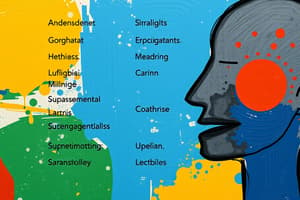Podcast
Questions and Answers
What is the process where a derived form is longer than the base root called?
What is the process where a derived form is longer than the base root called?
- Back-formation (correct)
- Morphology
- Affixation
- Derivation
The study of sounds used in language is called phonetics.
The study of sounds used in language is called phonetics.
True (A)
What serves as the powerhouse of speech production?
What serves as the powerhouse of speech production?
The lungs
The organs used in the production of speech sounds are known as the ______ organs.
The organs used in the production of speech sounds are known as the ______ organs.
Match the organs of speech with their functions:
Match the organs of speech with their functions:
What is the first step you should take before starting to write notes during a lecture?
What is the first step you should take before starting to write notes during a lecture?
Using too many abbreviations in your notes can make them difficult to understand.
Using too many abbreviations in your notes can make them difficult to understand.
What should you write down in your notes?
What should you write down in your notes?
Using __________ in note-taking can help save time and space.
Using __________ in note-taking can help save time and space.
Match the abbreviation with its meaning:
Match the abbreviation with its meaning:
Which symbol is used to represent 'not equals to'?
Which symbol is used to represent 'not equals to'?
Leaving wide margins in your notes is unnecessary.
Leaving wide margins in your notes is unnecessary.
Name one symbol that can be used in note-taking.
Name one symbol that can be used in note-taking.
What type of morpheme cannot stand alone and must be attached to a free morpheme?
What type of morpheme cannot stand alone and must be attached to a free morpheme?
Derivational morphemes change the lexical word class of the root they attach to.
Derivational morphemes change the lexical word class of the root they attach to.
What is the role of a root morpheme in word formation?
What is the role of a root morpheme in word formation?
The process of adding morphemes before or after a root to create new words is known as __________.
The process of adding morphemes before or after a root to create new words is known as __________.
Match the following examples with their corresponding morpheme types:
Match the following examples with their corresponding morpheme types:
Which of the following is an example of an inflectional morpheme?
Which of the following is an example of an inflectional morpheme?
Blackboard consists of one morpheme.
Blackboard consists of one morpheme.
Provide an example of a derivational morpheme that changes a verb to a noun.
Provide an example of a derivational morpheme that changes a verb to a noun.
Flashcards
Skimming
Skimming
Glancing quickly through a text to understand its main points or central idea.
Scanning
Scanning
Quickly searching a text for specific information, like keywords or dates.
Extensive reading
Extensive reading
In-depth study of course materials, usually for academic purposes, involving critical analysis and reflection.
Reading for specific purposes
Reading for specific purposes
Signup and view all the flashcards
Finger pointing habit
Finger pointing habit
Signup and view all the flashcards
Vocalized reading
Vocalized reading
Signup and view all the flashcards
Regression
Regression
Signup and view all the flashcards
Bad reading position
Bad reading position
Signup and view all the flashcards
Listening Skills
Listening Skills
Signup and view all the flashcards
Predicting Content
Predicting Content
Signup and view all the flashcards
Guessing Unknown Words
Guessing Unknown Words
Signup and view all the flashcards
Identifying Relevant Points
Identifying Relevant Points
Signup and view all the flashcards
Recognizing Intonation Patterns
Recognizing Intonation Patterns
Signup and view all the flashcards
Discourse Markers
Discourse Markers
Signup and view all the flashcards
Concentration and Avoiding Distraction
Concentration and Avoiding Distraction
Signup and view all the flashcards
Cultivating the Right Attitude
Cultivating the Right Attitude
Signup and view all the flashcards
Expository Essay
Expository Essay
Signup and view all the flashcards
Argumentative Essay
Argumentative Essay
Signup and view all the flashcards
Formal Letters
Formal Letters
Signup and view all the flashcards
Explanatory Writing
Explanatory Writing
Signup and view all the flashcards
Informal Letters
Informal Letters
Signup and view all the flashcards
Formal Letter Heading
Formal Letter Heading
Signup and view all the flashcards
Formal Letter Opening
Formal Letter Opening
Signup and view all the flashcards
Formal Letter Body
Formal Letter Body
Signup and view all the flashcards
Active Listening
Active Listening
Signup and view all the flashcards
Understanding
Understanding
Signup and view all the flashcards
Summarizing
Summarizing
Signup and view all the flashcards
Abbreviations
Abbreviations
Signup and view all the flashcards
Symbols
Symbols
Signup and view all the flashcards
Space for Additional Insights
Space for Additional Insights
Signup and view all the flashcards
Wide Margins
Wide Margins
Signup and view all the flashcards
Speed with Symbols
Speed with Symbols
Signup and view all the flashcards
Bound Morpheme
Bound Morpheme
Signup and view all the flashcards
Free Morpheme
Free Morpheme
Signup and view all the flashcards
Root Morpheme
Root Morpheme
Signup and view all the flashcards
Inflectional Morpheme
Inflectional Morpheme
Signup and view all the flashcards
Derivational Morpheme
Derivational Morpheme
Signup and view all the flashcards
Affixation
Affixation
Signup and view all the flashcards
Prefix
Prefix
Signup and view all the flashcards
Suffix
Suffix
Signup and view all the flashcards
What is back-formation?
What is back-formation?
Signup and view all the flashcards
What is phonetics?
What is phonetics?
Signup and view all the flashcards
What is the role of 'spent air' in speaking?
What is the role of 'spent air' in speaking?
Signup and view all the flashcards
What is the role of the lungs in speech?
What is the role of the lungs in speech?
Signup and view all the flashcards
What are the organs of speech?
What are the organs of speech?
Signup and view all the flashcards
Study Notes
Course Information
- Course title: Use of English
- Course code: GST 101A
- Semester: First
- Level: 1000
- Institution: Gallant 4 SUG
Course Outline - Language
- Language is arbitrary
- Language is conventional
- Language is dynamic
- Language is systematic
- Language is not instinctive
Course Outline - Reading
- Scanning reading
- Skimming reading
- Extensive reading
- Intensive reading
Course Outline - Listening Skills
- Dictionary & its uses
- General dictionaries
- Specialized dictionaries
Course Outline - Word Formation/Building & Processes
- Morpheme
- Derivational & inflectional morpheme
- Affixation
- Compounding
- Conversion
Course Outline - Outlining
Course Outline - Writing & Speaking Skills
- Narrative essay writing
- Descriptive essay writing
- Expository essay writing
- Argumentative essay writing
- Letter writing
Reading and Types of Reading
- Reading is a communication process where the reader tries to understand the writer's ideas
- Reading involves skills like visualizing, interpreting graphemes, symbols, and more
- Different reading approaches include skimming, scanning, extensive reading, and reading for specific purposes
- Reading effectiveness depends on the reader's knowledge of the language's alphabets and phonemes
Factors Affecting Effective Reading/Faulty Reading Habits
- Finger pointing habit: tracing the print with hands
- Vocalized reading: reading aloud
- Reading under the influence of alcohol
- Regression: moving back while reading
- Reading in poor positions: reading while standing or lying in bed
Listening Skills
- Listening is a primary language skill essential for communication
- Definitions of listening from various sources
- Listening involves actively decoding, understanding and interpreting sounds or messages
- Effective listening requires focusing on important information, especially in academic settings
Types of Listening
- One-way listening: focused listening to learn
- Two-way listening: interactive and involved dialogue
Factors Affecting Effective Listening
- External factors: noisy environments or unfamiliar vocabulary or jargon-filled messages
- Listener's internal factors: attitudes, personal concerns, biases, and bad habits
Writing and Types of Writing
- Writing is a process of using characters, symbols, and sounds to communicate
- It's a literacy skill that can be improved through practice.
- Writing involves stages including pre-writing activities; writing the draft; editing to proofread and make sure errors are free.
Characteristics of Good Writing
- Good organization
- Accurate expression of meaning (coherence and clarity)
- Conciseness in using words (avoiding verbosity)
- Simplicity in the style
Types of Writing
- Narrative: presents accounts of events, characters, and actions
- Descriptive: describes events, objects, people or personalities using imagery and details
- Argumentative: presents opinions, analyses, debates to show viewpoints
- Expository: explains a subject matter, process, ideas, concepts and terms clearly and logically
Features of a Formal Letter
- Format: writer's address, date
- Indented or block format
Basic Skills Needed for Effective Writing
- Clarity: clear expression without ambiguity
- Economy: managing words/phrases, proper proportion
- Accuracy: precise use of grammar, pronunciation, vocabulary
- Simplicity: avoidance of overly complex language
Note Taking and Note Making
- Note taking is writing down key points during lectures, readings, or discussions
- Note making is creating summaries or analysis of info
- Effective note-taking involves selecting relevant info from a lecture
- Note-making helps to study/review and remember info
- Good notes can be created using symbols, abbreviations, consistent headings, and margins.
Outlining
- Outlining is a method for representing content and structure
- It includes main ideas, secondary ideas, and sub-divisions
- Outlining helps to arrange ideas logically and clearly for reading and revision
The Dictionary and Its Uses
- A dictionary is a collection of words organized alphabetically and contains definitions, synonyms, etymology, and origins
- Dictionaries may be general or specialized covering specific fields
- Dictionary uses include finding meanings, synonyms, antonyms, the parts of speech of words, etymology, pronunciation, usage.
Speaking Skills
- Speaking and speech involve using sounds for expression
- Speech organs facilitate meaningful sounds.
- Speech is complex with tones, articulators and intonation
- The organs of speech include lungs, glottis, soft palate, hard palate, tongue, teeth, lips, nasal and oral cavities
- Articulatory organs are used to produce speech
Classification of Speech Sounds
- English sounds are categorized by their production (e.g. manner, place, state of glottis):
- Plosives, Fricatives, Affricates, Nasals and Approximants (also called Semivowels) etc.
Syllables
- English language is made up of sounds or components (Syllalbes) which include Onset, Peak, and Coda
- These components combine to make up words
Studying That Suits You
Use AI to generate personalized quizzes and flashcards to suit your learning preferences.
Related Documents
Description
This quiz covers key concepts in linguistics, including phonetics, morphemes, and the functions of speech organs. Additionally, it addresses effective note-taking strategies, such as the use of abbreviations and symbols. Test your understanding of these essential topics!




